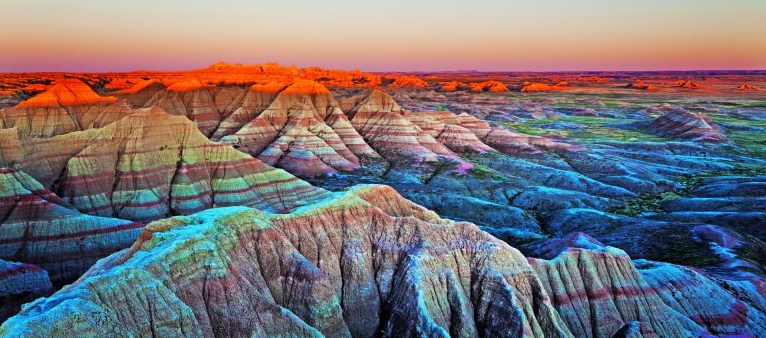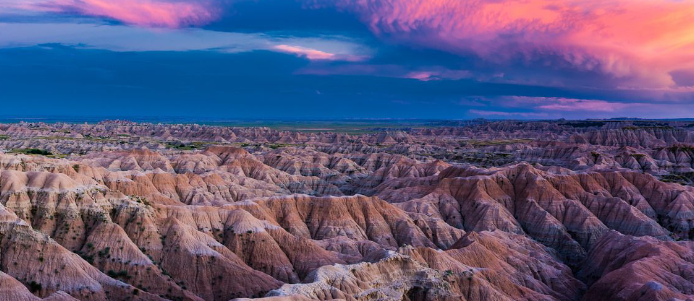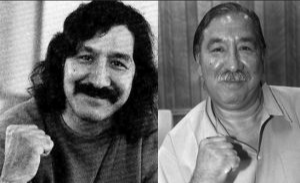
Watching Thunderheart taught me more about Indigenous resilience and struggle, one that, while not my own Alaskan Native story, felt deeply familiar. It gave me different ways of viewing things from the perspective of the Sioux people. The movie was filmed on the Pine Ridge Reservation in South Dakota near the Badlands and significant historical events like the Wounded Knee occupation. The film deeply connects with sovereignty, identity, resistance, racism, poverty, and land misuse.

From the beautiful landscapes of South Dakota to the rich ways of Sioux community life, this movie captures the spirit of the Native people’s connection to their land. This land, with its deep historical scars and sacred energy, shapes the lives of its people, offering both a source of strength and a battleground of exploitation and neglect. The difference between the spiritual ways the Sioux hold for their land and the external greed desecrating it mirrors a universal Indigenous struggle, one that my own community understands all too well. The greed for monetary gain of mining for uranium shows how the Western world has affected the disregard for the land and how mining will destroy the water, land, animals, people, and the environment.

Ray Levoi’s journey through this landscape, initially marked by a detachment stemming from his mixed heritage, mirrors the personal narratives of many Indigenous people. His father, being of half-Native American descent, faced the same kind of disrespect and inhumane treatment that many Native people have historically encountered and continue to experience today. The Western people could not relate to the traumas many Natives endured, such as loss of culture, identity, and boarding schools. Levoi’s loss of identity was evident by the way he was trying so hard not to be Native. His transformation from an outsider to a man starting to connect with his roots and the injustices facing his people speaks to the power of returning to one’s cultural and spiritual origins. It’s a powerful reminder of the healing and understanding that comes from embracing our identities.

Through characters inspired by real-life figures like John Trudell and Leonard Peltier, the film pays homage to the courage and sacrifice of those who stood up against systemic oppression. With his genuine activist background, Trudell brings genuineness to the story, surpassing acting. At the same time, Peltier’s story symbolizes the ongoing battle for justice and sovereignty. Thunderheart revealed how closely it lines up with Leonard Peltier’s real-life story. It’s like the movie took bits of his life, Peltier being a big figure in AIM, wrongly jailed since ’75 over a shootout with the FBI, and described it into Jimmy Looks Twice. The way Jimmy’s story reproduces Peltier’s, especially when he talks about not being broken, captivated me. It’s like hearing Peltier’s own words from his book, where he says they can’t lock up his spirit. And then, seeing Levoi running with the ancestors at Wounded Knee, shot in the back, I couldn’t help but think of Peltier’s vision he shared from prison. Here is a link to his book if anyone is interested: Prison writings : my life is my sun dance : Peltier, Leonard : Free Download, Borrow, and Streaming : Internet Archive

The movie doesn’t stop showing how messed up the situation with the FBI was, either. I hope folks who read this get why Thunderheart isn’t just another movie for me. It’s a reminder of the fight and spirit of Native people, inspired by real heroes like Peltier. These moments, these deliberate nods to Peltier’s case and his writings enrich the film’s narrative, offering viewers a glimpse into the heart of Indigenous resistance. Through this blog, I also hope that more people will understand the layers of meaning in Thunderheart and Native communities, seeing it not just as a story of individual heroism but as a voice to the enduring fight for justice and sovereignty in Native communities.
As an Alaska Native, the portrayal of these struggles, though specific to the Sioux, resonates universally. The fight for our lands, the preservation of our cultures, and the dignity of our peoples are threads that bind all Indigenous communities. Thunderheart tells these stories in a compelling description that shows the specific injustices faced by the Sioux and shines a light on the shared experiences of Indigenous resistance. It reflects the Indigenous spirit’s endurance, is a commendation to those who’ve fought for our rights, and inspires ongoing advocacy. It reminds us of our shared history, collective pain, and unwavering resilience. Through this exploration, I honor the memory of those who’ve paved the way for our voices to be heard and to spread the importance of solidarity among all Indigenous peoples in our continued quest for justice and sovereignty.

This movie, especially Grandpa, will have me watching it many more times. And I also hope that Peltier got to watch this movie. His next parole hearing is set for July 2024. My heart aches for his unjust jail sentence. Here is a link to Amnesty International Campaign for Peltier: Campaign: President Biden Should Free Leonard Peltier | Amnesty International USA (amnestyusa.org)

Comments
4 responses to “Thunderheart (1992)”
Hi Danelle, this is a nice blog, very well put and written. This is the first time that I’ve watched this movie, just finished it on Amazon Prime. Watching this confirms my thinking of why so many Alaska Natives also die of cancer. All the mining on our lands and the waste not being disposed of properly or environmentally. Both my parents and both my grandfathers all died from cancer, and many other relatives are battling it right now. The 20 minute video about the uranium mining on Pine Ridge was very eye opening, thank you for sharing it. It gives a deeper perspective of what really happened versus the movie, although the movie was a good one. I hope Peltier gets paroled or freed. Thank you for your blog, I enjoyed reading it.
Hi Victor, thank you for responding to my blog. I’m glad you got the chance to watch it. I was amazed that I had not seen this before, as I love watching media that includes real Native actors and representation. I have also thought about the reasons why cancer rates seem so high among Alaska Natives. The nuclear testing in the Aleutians and wartime bombings have always made me wonder about their impact on our health. Plus, changing from our traditional diets to more Western ones probably hasn’t helped either. It is hard to comprehend how mining companies can show no compassion for the land, environment, or people when they create these mining sites. I’m not sure how much more our environment can take.
I’m really sorry to hear about your family having to go through that horrible disease. I also lost my dad to cancer in 2003, and I’m still working through it to this day.
It’s funny how you can watch a movie without actually seeing what was being portrayed. When I saw the movie on the watch roster, I was like “I remember that, but I thought it was more of an American Native “X-files” movie. Of course, now, I work in Indian health, and have a broader knowledge base of the issues that surround the reservations and botched treaties. I liked your post, and am glad you posted the Leonard Peltier link. It’ll be interesting to see what kind of decision happens. (you can’t really call it justice, not matter what at this point.)
Thanks for your post.
Hi Danelle, fantastic job on your blog. You provided an informative analysis and summary on the movie, as well as utilizing tidbits from Peltier’s book and real world experiences. You connected the film to history, academia, the book, and your personal experience in a clean cut and easily understandable way. The Ted Talks and additional Youtube videos were great additions for further understanding and expanding on the original material as well. What stood out to me the most and that I truly valued being able to read and learn about was how you connected your personal experience as an Alaska Native in comparison to the experiences you were able to analyze and reflect on that the Sioux went through. I appreciate you sharing and I look forward to reading more of your blogs in the future.